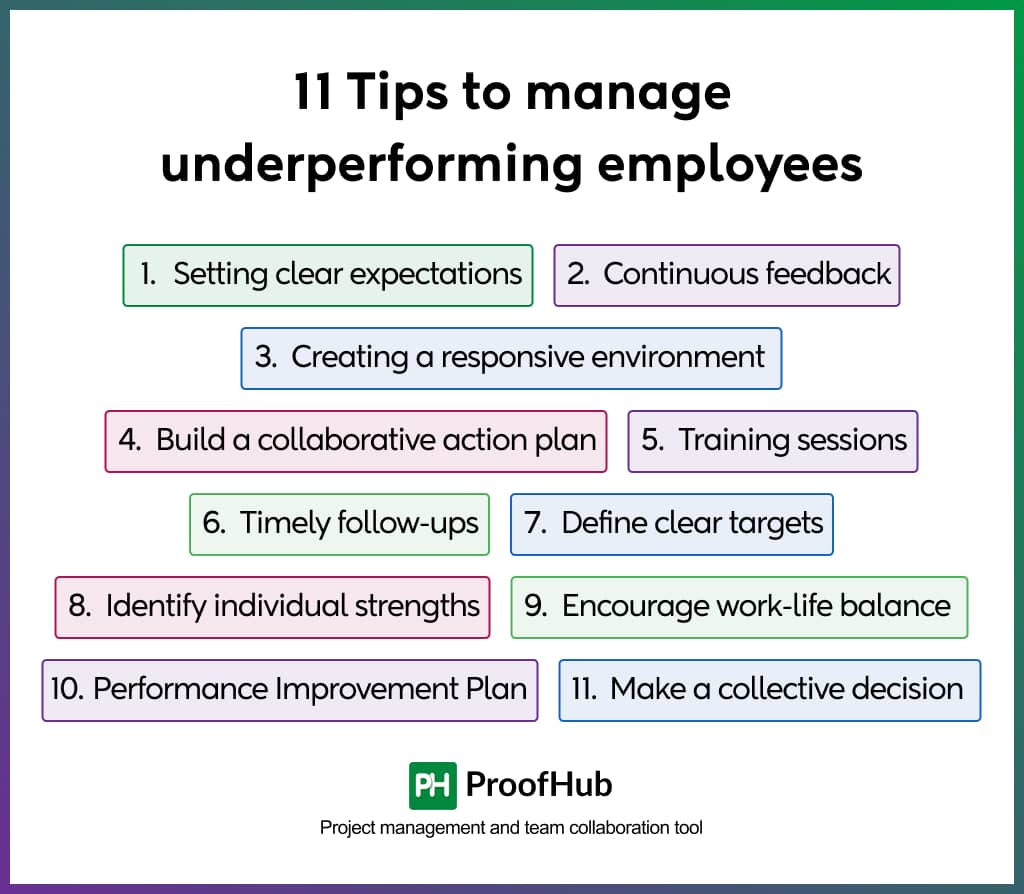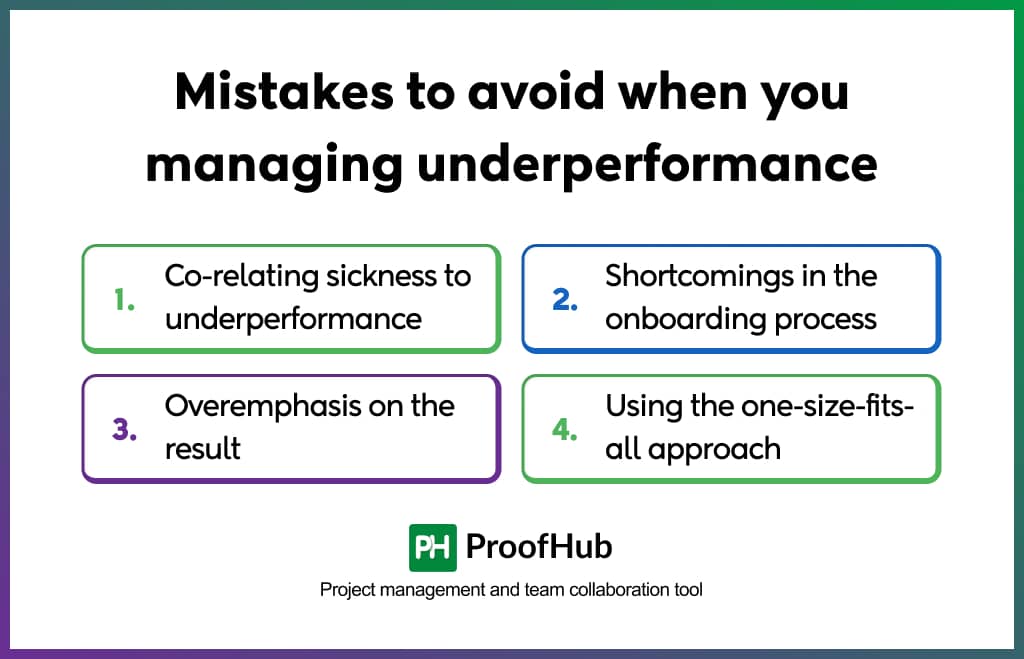Managing underperforming employees is one of the biggest challenges for any manager. The growth of any organization depends on a productive workforce, but when employees struggle to meet expectations, it impacts overall business performance.
So, when your team is underperforming and needs your support, what should you do?
This article will help you effectively manage underperformance, understand its root causes, and implement actionable strategies to boost your team’s productivity.
What is underperformance?
Underperformance refers to an employee’s inability to meet the expected standards of their job. It can include missing deadlines, producing low-quality work, lacking motivation, or failing to meet key performance indicators (KPIs).
Underperformance is not only limited to the performance of an individual. This also includes signs such as:
- Spreading negativity
- Inappropriate behavior in teamwork
- Significant friction with team members
- Intentionally violating rules and regulations
To put underperformance into perspective, these statistics show the hindrance caused by underperforming employees.
Underperforming employees make a 25% lower contribution to the organization. Furthermore, they have only a 14% chance of staying with the organization.
This clearly depicts the need to identify underperformance early. So you can solve the issue before it becomes a major hurdle.
What are the causes of underperformance?
Underperformance can arise from various factors, including personal, professional, and organizational issues. To address these issues, you need to find the root cause of the problems. Here are some common causes, along with explanations:
1. Personal issues and stress: Health problems, family responsibilities, or mental health struggles can impact an employee’s ability to focus and perform well at work.
2. Unclear job expectations: Employees may underperform if they are unsure about their responsibilities or goals. Managers must set clear expectations and provide clear instructions to ensure employees understand their roles.
3. Work overload or burnout: When employees are overworked, the quality of their work can decrease, leading to fatigue and underperformance.
4. Lack of skills or training: Employees may struggle if they lack the necessary knowledge, expertise, or technical skills required for their role. They may find it difficult to complete tasks efficiently without proper training, leading to poor performance.
5. Lack of resources or tools: To perform tasks efficiently, employees need the right tools, software, and resources. Their efficiency and productivity may decline if they are not offered the necessary technology and tools. Use team management and collaboration tools to close the gap between you and your team.
6. Poor management or leadership: If leadership/managers fail to provide direction, feedback, or support to their team, employees may feel demotivated and underperform.
7. Poor workplace culture: A toxic work environment that lacks teamwork can negatively impact employees’ morale and productivity. When employees do not feel supported or appreciated, their performance may suffer.
8. Inadequate feedback and recognition: A lack of constructive feedback and appreciation can make employees feel undervalued, decreasing motivation and performance. Employees require regular feedback to understand their areas for improvement and how they are performing.
11 Tips to manage underperforming employees

The following 11 tips will help you manage underperforming team members efficiently.
1. Setting clear expectations
When managing the performance of your employees, setting clear expectations is essential. When you convey clear expectations to your employees, they work with improved efficiency.
Clear expectations also serve the purpose of job security. Employees tend to underperform if they are under the impression that their job is at stake.
Further, while setting expectations, ensure that they are realistic and achievable. Understand and examine the potential of your employees.
There are chances that your employees have not understood their job description. So, it all comes down to setting realistic and clear expectations. This is the best method of dealing with your underperforming employee.
2. Continuous feedback mechanism
Feedback sessions provide you with the opportunity to understand issues from both sides. When you are aware of the perspective of your employees, you can guide them with ease.
A continuous feedback mechanism helps in building an environment of trust. Your employees must know that their opinions are being listened to. They will get the added motivation to complete tasks on time.
Two-way feedback helps you to understand the reasons why your employees are underperforming. This will assist you in root cause analysis. You can solve the issue once and for all.
Positive feedback and recognition can motivate your employees. This helps in improving the productivity of your employees.
3. Creating a responsive environment
Underperformance starts when your work environment becomes redundant. And in no time, a redundant workplace becomes a toxic workplace. Employees do useless things when they are not occupied to their full potential.
Toxicity in a workplace is like poison. It affects team members in different departments. If you are late to take corrective measures, it will hinder the productivity of your company.
A responsive environment builds a culture of togetherness with a strong team bond. This plays a key role in keeping your team members on the same page.
A responsive work environment provides an advantage in identifying problems early. You can easily spot declining productivity and lower morale.
4. Build a collaborative action plan
Develop a positive rapport with your underperforming employees. Keep them together when making key decisions. This will increase accountability and motivate them to improve.
The essence of working out an action plan together is to find suitable opportunities. You can look at options such as job redesign, or retraining. This will encourage employees to fix goals for their improvement.
Involve your employees while creating an action plan. This will help you identify issues related to their personal life. In such cases, you can prevent company resources from going down the drain. You can make corrective decisions with ease.
Additionally, you can provide time off for your employees in case of any personal issues. However, it all depends on the nature and experience of the employee.
Make youremployees accountablewith these actionable tips for success.
5. Training and development sessions
The old wise saying – “Practise makes a man perfect.”
Provide underperforming employees with adequate training. Ensure that they have a complete understanding of the prevalent work ethics.
Supervisors play a crucial role in understanding the shortcomings of the employees. This helps you to plan and devise training schedules. With an efficient training mechanism, you improve the performance of the employees. Additionally, you can save revenue in the process.
You might face an extra challenge with remote workers. Your observation is narrow. Remote workforce management requires you to conduct additional research. This is necessary to understand their mindset. Efficient OKR (Objectives and Key Results) helps you easily manage remote workers.
6. Timely follow-ups and check-ins
Follow-up meetings provide you with a clear picture of the training and development. You can understand the growth of your employees.
Further, you can design an effective schedule and roadmap with this information. With follow-up and check-ins, you can establish a clear cause for underperformance. This will help you to sabotage the root causes of underperformance completely.
You can build a culture of trust in your work environment with consistent support. This will help your employees to deliver the expected results.
7. Define clear targets
When dealing with an underperforming employee, do not ‘water down’ the reality. Establish clear expectations and convey them to your employees in a positive manner. Provide them with an effective timeframe, before which you want to see changes.
When you water down your response to a situation, employees tend to make that their habit. They continue making more mistakes before they boil up the entire workplace.
Another reason is that employees want to take in what they are comfortable listening to. This is because of their self-esteem. And in situations where targets are not clear, employees tend to make assumptions.
The work breakdown structure in the statement of work will come in handy. You can create timesheets with that data. This will serve as a disclaimer for your employees. The documented process will warn them of failing to achieve the target.
8. Identify individual strengths
In some cases, employees end up in the wrong positions. Your leadership skills come to the fore when you identify such issues. This will help you in efficient employment planning.
Although this is a matter of subjectivity, different employees have different strengths. In some cases, employees themselves do not apprehend their own strengths.
You can create an effective strategy for individual employees. This will streamline the improvement process.
9. Encourage a healthy work-life balance
A healthy work-life balance is a secret hack! Employees with a healthy lifestyle perform better at the workplace.
Surprising, isn’t it?
Working in a stressful work environment leads to fatigue. This leads to a loss of motivation and results in underperformance.
Encourage your employees to have a positive lifestyle. When your employees spend too much time at the work desk, they go through enormous stress.
Provide employees with time off. Additionally, you can also provide them with wellness training. This will lower the stress, strain, and workload pressure. Such employees work with enhanced concentration.
10. Performance Improvement Plan (PIP)
This is a step that you should resort to at the last. Provide more than one opportunity for underperforming employees to rectify the issue. Never use PIP as the first method to solve underperformance in your team members.
PIP is a roadmap that is a legal document when terminating an employee. This depicts that the employee is not improving their performance after repeated attempts.
Human resources professionals play a key role in implementing PIP. This will provide you with a clear result. Either you will see an improvement in the performance of your employees or a training gap.
Note: Rectify the training gap with efficient planning and implementation. In other cases, a gap can also show an employee who is unwilling to improve and is a ‘bad hire’.
11. Make a collective decision
In some cases, employees do not learn and repeat mistakes repeatedly. Then, it is not an underperforming employee. That is a ‘bad hire’.
Bidding goodbye or terminating an employee may feel sad. Certain endings are necessary for fresh beginnings.
You must accept that things do not always work out however you want them to. In such cases, ending your efforts and looking for a different employee is better.
Let me conclude with the Journal of Society for Human Resource Management phrase. “Immediate termination may be appropriate for egregious misconduct.”
After all, the basic accountability lies with your employees. You cannot expect them to change overnight because you want them to.
Note: Document every step of your effort in the improvement process as evidence. Ensure that you terminate the agreement as per the local rules and regulations.
Why is it critical to identify underperforming employees?
Identifying underperforming employees is crucial for maintaining a productive and efficient workplace. It can not not only affect team performance but also the organization. Here’s why it is important to identify underperformers:
1. To prevent productivity loss
Underperforming employees can slow workflows, delay projects, and reduce team efficiency. Identifying under-performers early allows you to reassign tasks, provide support, or set clear expectations to keep the project on track.
2. To keep team morale high
When one employee underperforms, it can put extra pressure on their colleagues, leading to frustration and demotivation. Identifying and resolving underperformance helps maintain a positive work environment, strong team morale, and boosted productivity.
3. To improve work quality
Poor performance can lead to errors, missed deadlines, and lower-quality work. You can provide support, training, or feedback by identifying struggling employees to ensure your team can work efficiently.
5. Reducing turnover and hiring costs
If underperformance is not addressed, it can lead to resignations or terminations, increasing recruitment and training costs. Proactively identifying and supporting employees to improve their performance can help retain talent and reduce turnover expenses.
6. Boost client satisfaction
When employees underperform, it can negatively impact customer service, product quality, or business operations. Addressing performance issues ensures customers receive the best possible service, protecting the company’s reputation.
7. Helping in strategic decision-making
Managers can make informed decisions about promotions, restructuring, or training programs by monitoring employee performance. This allows the company to allocate resources effectively and enhance overall workforce efficiency.
What are the signs of underperformance in the workplace?
There is a fine line that separates improvement tips from micromanagement. Therefore, let’s first look for signs that indicate underperformance:
- Coming in late for work
- Calling in sick frequently
- Lacking energy and enthusiasm
- Failing to demonstrate teamwork
- Creating conflicts with co-workers
- Violence / Rude behavior with peers
- Struggling to achieve their milestone
- Laziness / Negligence towards tasks
- Making the same mistakes repeatedly
- Frequent and uninformed absenteeism
These above signs will help you identify underperforming employees. In the next section, we will discuss dealing with underperforming employees.
What mistakes should you avoid when you are managing underperformance?
To efficiently handle underperforming employees, you should not make decisions based on your instincts. Strategic management helps you prepare a roadmap. This will help you manage employees with ease.

I have seen managers going hard on underperforming employees. This may backfire and result in wrongful termination. Frequent mistakes in handling employee underperformance include:
1. Co-relating sickness to underperformance
One of the most common mistakes in identifying underperformance is sickness. Employees’ performance can be low when they return from prolonged sick leave. This is not an underperforming employee. Employees take some time to get back to routine.
2. Shortcomings in the onboarding process
There are cases when the employee is new to the company and has not adapted to the work environment. This happens when the workplace is overwhelming. Sometimes, it could be because the employee was not provided an effective induction.
The onboarding process plays a key role in moulding and adapting an employee. This lays the foundation for employees to understand their expectations.
3. Overemphasis on the result
While working with an underperforming employee, the improvement process is continuous. You need to prepare a roadmap with a steady development plan.
Celebrating small wins and recognition is crucial to the improvement process. Focussing on the result will lead to enormous stress on the employee. This will spoil the entire process.
4. Using the one-size-fits-all approach
Different employees have different mindsets. You cannot expect your employees to respond to changes similarly. Organize the resources in your workplace. This will help your employees to be productive. They will also be able to overcome their differences and work together.
Employees face difficulty when they are not given space. They lose morale and fall to the verge of giving up.
Boost team morale, streamline operations, and foster a culture of success.Explore these apps now!
Conclusion
Underperformance is a key issue that hinders productivity and the scheduled workflow. Look for symptoms early. This helps you to take corrective measures on time.
Effective managers understand their employees better and bring out the best in them. It is not necessary to deal with underperformance with an iron hand. Instead, an effective roadmap will help you in the process.
FAQs:
What should managers do first when faced with poor performance?
The first step when noticing poor performance is initiating a constructive feedback session. After identifying the root cause of the problem, create a roadmap for improvement. Follow up the discussion with check-in meetings. This will ensure that the employee is improving and on the road toward progress.
How do managers evaluate employee performance?
Managers evaluate employee performance with regular assessments and timely feedback sessions. You can also take help from Key Performance Indicators (KPI). Continuous monitoring plays a key role in identifying employee performance. This will help you to take corrective action on time.
What is HR's role in handling performance issues?
HR plays the role of a bridge. They organize conversations between the employees and the management. They keep track of the employee performance over time. This ensures a fair and consistent work process. They focus on the all-round improvement of the individuals.
How do you motivate an underperforming employee?
The primary step in motivating an underperforming employee is to provide constructive feedback. You can create a roadmap for their improvement. Further, provide training and skill development sessions to underperforming employees. This will help to build motivation and improve the performance of the employees.

